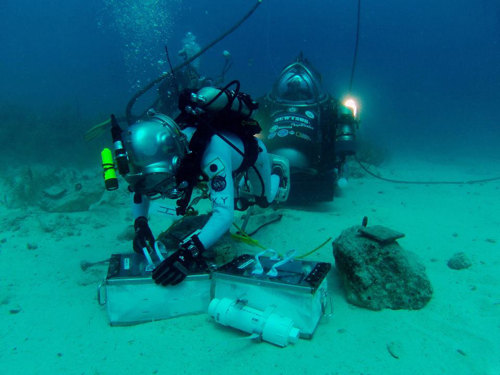By Aquanaut Steve Squyres (Cornell University)
Today was the coolest day of the mission for me.Today we moved from engineering to science.
Engineering and science are different things. Engineers are inventors. Theirjob is to design and build things that people can use. Engineering requiresenormous creativity, and creativity of a very special kind: creativity that iscoupled with practicality. The stuff engineers build actually has to work.
 Image at right: Aquanaut Kimya Yui (JAXA) collects chipping samples from a rock simulating an asteroid boulder.
Image at right: Aquanaut Kimya Yui (JAXA) collects chipping samples from a rock simulating an asteroid boulder.
Scientists, on the other hand, are seekers of truth. Their job is to figure outhow the world works. Science requires intuition, knowledge that is based on thework of many other scientists, and sometimes a fair amount of luck.
What we’ve been doing at NEEMO so far has been engineering in the service ofscience. We’ve been testing out hardware that was designed and built byengineers, using the procedures they recommended to us. Our job has been tofind out what works and what doesn’t, and to relay that information back to theengineers. They build, we test, they make changes, and we test again. Someday,on an asteroid, the stuff that works best is going to be used to do science onthat asteroid. We’ve been doing the engineering work to help make that futurescience possible.
But today was different. On our EVAs today we had no engineering tests toperform. Instead, our job was to explore, to report what we found back toMission Control, and then to collect the samples they wanted us to collect.
The cool thing about this is that when we went out the door we didn’t know whatwe were going to find. The surface of our “asteroid” isreconfigurable, and the day before some clever people had gone out there, setup some challenges for us, and had not told us what they’d done. It was up tous to figure it out.
Just like any other field scientists, we started with reconnaissance, flyingabove the surface with jetpacks and reporting back to Mission Control what wediscovered. On the spot, they came up with a science plan for us, just as wouldhappen with a crew at an asteroid. And then it was up to us to use all thetools we had at our disposal, in whatever way we thought best, to carry outthat science plan.
When Kimiya and I did this on our morning EVA, we relied a lot on our jetpacks.Dottie and Tim made more use of the translation lines and the booms to do theirsampling. Both approaches worked, but in different ways. It was reallyinteresting to debrief after dinner, and compare notes on our experiences.
But most of all, these EVAs felt like real scientific field work to me.It was a taste of how it’s really going to be to explore an asteroid and Ithink it was a big step forward for NEEMO and NASA, and something that’ll takeus a significant step closer toward doing it for real someday.
To learn more about NEEMO visit www.nasa.gov/neemo.
